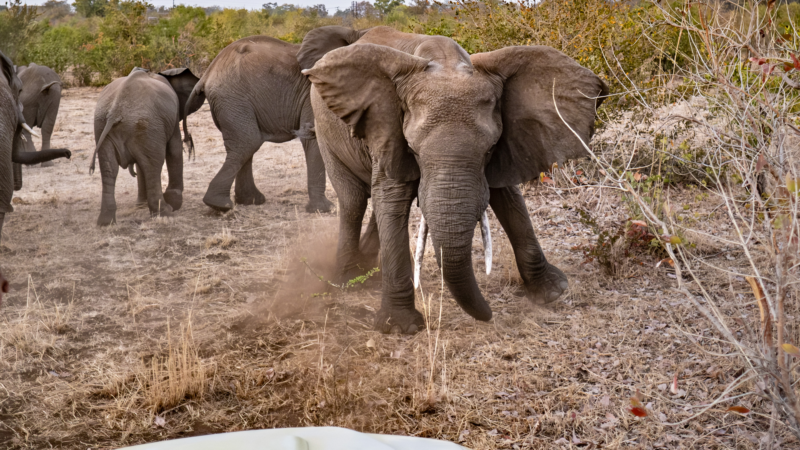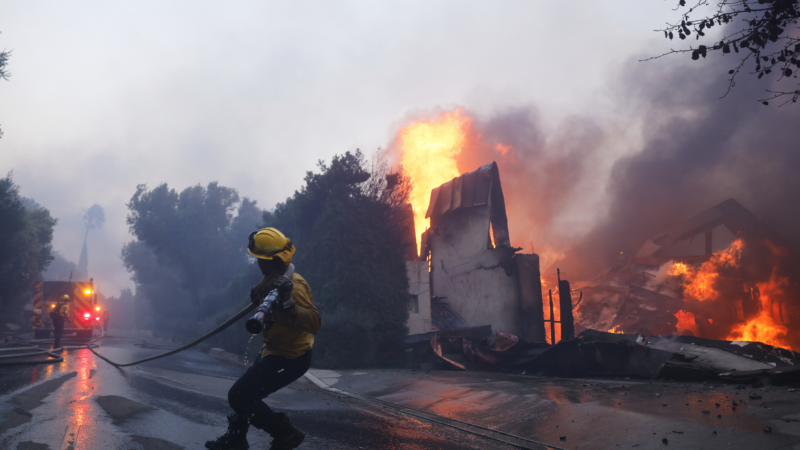PHOTOS: Take a ride with the Elephant Response Team. And be careful!
The emergency call comes in just before midnight. In the driver’s seat of a battered Toyota Hilux pickup truck, 29-year-old Chamunolwa Jimayi chats briefly with the caller. He hangs up the phone and shouts to his two colleagues in the back to hold on tight, then shoots off at high speed through the city center, careening around the traffic.
Jimayi’s job is not your regular 9-to-5. He’s a member of a three-man Elephant Response Team fighting to keep the peace amid a worsening and at times deadly conflict between humans and the world’s largest land animal. His hometown of Livingstone, Zambia, lies on the edge of the Mosi-oa-Tunya National Park and has long witnessed incidents of human-wildlife conflict. But the combination of recent urban expansion and successive poor rainy seasons has led to a dramatic escalation.
“Sometimes we get more than 30 calls in a day,” says Jimayi, who receives only a stipend of around $140 a month. “The game park is almost completely dry. So the elephants are just coming into the community to feed. We’ve been receiving a huge number.”
As he drives, signs of elephant incursions are visible all around: cinderblock walls with gaping holes, splintered mango, acacia and mopane trees, freshly deposited piles of dung. Strings of old beer cans and potato chip packets, designed to scare away elephants, adorn the walls of roadside homes.
With his favorite reggae playlist straining the vehicle’s dust-choked sound system, Jimayi heads for the suburb of Linda, where he’s learned that a pair of elephants are wreaking havoc in a residential area. Tensions there are high after a string of deaths caused by elephants. If the community responds with aggression, the situation could become volatile, putting both people and elephants in danger.
“They’re friendly animals. They don’t come to harm anyone,” says Jimayi, who has a deep appreciation and respect for elephants. “But not everyone understands what I see in them. The community is really scared of these animals. And some are angry. People have lost their loved ones. Our goal is to keep the community and the elephants safe.”
By the time Jimayi and his colleagues arrive at the scene, one of the elephants has disappeared back into the bush. He finds the other walking along a residential street and maneuvers the truck to try and cut it off.

A brief standoff ensues as Jimayi and the elephant size each other up, neither willing to back down. “Easy boy, back you go,” he shouts through the open window. A few moments later, the elephant starts to run. Revving his engine, Jimayi pursues it through the streets of Linda, turning this way and that to channel it away from the settlement until eventually it ducks beneath a footbridge and disappears into the darkness in the direction of the national park.
The Elephant Response Team gets going
This has been Jimayi’s life since 2019 when the Elephant Response Team was launched by a small Livingstone-based nonprofit, the Conservation and Tourism Society, in response to what was already, long before the drought began, a growing problem of human-wildlife conflict. With a total budget of barely $40,000 per year, CATS also helps search the national park for snares set by bushmeat poachers and carries out an extensive conservation education program designed primarily to teach people how to stay safe around elephants. The advice includes tips such as: always stay at least 300 feet from an elephant, never confront them and don’t expect to outrun them: elephants can hit 28 mph.

They also teach residents about the different forms of elephant deterrents available to protect their homes and gardens, like reflector fences and “chili bricks” — a potent mix of elephant dung, used engine oil and fresh chili peppers that produces a noxious smoke when burned.
The Elephant Response Team is based in Dambwa South, a neighborhood of single-story brick homes set in a maze of dusty streets on the edge of the National Park and one of the areas worst affected by human-wildlife conflict. Every evening through the long months of the dry season – typically between May and October — children gather along the park perimeter to watch the daily exodus of wildlife crossing into town in search of food.
Crocodiles hunt for prey in sewage ponds, hippos lumber past industrial buildings, and zebras and buffalo graze contentedly by the roadside, seemingly oblivious to their human audience. From about 7 p.m. onward, elephants take over the streets.
The park was once ringed by a fence but maintaining it has proved a challenge. Either it succumbs to elephant damage or is looted by residents looking to make a few dollars from the scrap metal. What remains are lines of empty fence poles and, here and there, a section of mangled wire flattened by the passage of animals. Park authorities say they are currently building a new one, with additional electric fencing in some areas, but Dominic Chiinda, director of the Department of National Parks and Wildlife, admits that a fence is unlikely to prove a lasting solution.

Since 1990, Zambia’s population has nearly tripled from 7.68 million to over 21 million. In that time, Dambwa South has sprawled outward to the point where, today, the outermost houses lie no more than 16 feet from the boundary of the national park.
“When we were growing up, there were no houses here,” says Jimayi, as he warms his hands over a campfire at the team’s base in Dambwa South. “This whole place was just full of trees. The elephants know this used to be their land.”
Tough life for the locals
For the residents of the homes nearest the park perimeter, life has become a daily struggle.
“This was the only house we could find,” says Janet Sikabonga, 36, who recently moved to the area with her husband and four children. “We didn’t know there would be elephants here. We thought they would be inside the national park.”

The previous night, Sikabonga had watched through her window as four elephants entered her front yard, destroying her water tap and her clothes line. Over the past few weeks, elephants had also destroyed her guava tree and her vegetable patch, prompting the family to abandon efforts to grow their own food. They no longer venture outside after dark.
“I don’t know what to do,” says Sikabonga, whose family relies on the money her husband earns doing odd-jobs for a Livingstone hotel, and who lacks the means to move again. “They destroy everything. Last night I was so scared I didn’t even sleep”.
Most incidents of human-wildlife conflict don’t result in physical injury, but deaths still occur on a regular basis. So far this year, the DNPW has reported 10 people killed by elephants in the town. One evening in August, 91-year-old tobacco trader Luka Chiyesu was on his way back from the market, following the same route he’d taken every day for years, when he encountered a herd of elephants.

“I found my father’s body just lying there in the bush,” recalls his son, also called Luka, as he sits on a plastic chair in the yard of his home in the Nakatindi neighborhood. “He died on the spot.”
Luka Jr, who grew up around elephants, always held them in great esteem, seeing them as “the mother of all animals.” Now, he feels conflicted.
“We used to live peacefully. Nobody was ever attacked by elephants,” he says. “Things have changed a lot. When they see us, they see an enemy. When we see them, we see an enemy. That day, if I had a gun, I’d have shot two or three.”
The death of Luka Chiyesu triggered anger in the community not only toward elephants but also toward the Department of National Parks and Wildlife over their perceived failure to protect communities living near the national park. After the old man’s death, it took hours for a DNPW vehicle to arrive on the scene. When one eventually turned up, an angry mob stoned it. None of those spoken to by NPR said they were aware of the Department carrying out elephant patrols in the area.
“They don’t care about the people anymore — they only care about the animals,” said Luka Jr, echoing a widely held perception in the town. “They say this is a corridor of elephants. They say it’s a wildlife area.”
Dominic Chiinda said the department does have a vehicle assigned to elephant patrols in Livingstone but that more are needed to effectively cover such a large area. He also said many of the “unfortunate incidents” of deaths and injuries caused by elephants were “self-inflicted,” alleging that some of the victims may have been drunk, and that villagers were planting their crops too close to elephant corridors. Chiinda said the department was trying to teach people about elephant safety, as well as distributing fireworks to affected communities to help them scare off elephants. They’re also providing supplementary food for wildlife in the National park.

Livingstone sits within the Kavango Zambezi Conservation Area (KAZA), the world’s largest terrestrial conservation area, which is home to more than half of Africa’s savannah elephants and more than 2 million people. Spanning five countries, it contains a kaleidoscope of protected areas connected by so-called wildlife corridors that allow animals to move between one national park or reserve and another along traditional migration routes.
The pachyderm puzzle
The approach has helped to sustain elephant numbers in the KAZA at a time when, elsewhere on the continent, they are in decline. Yet for people living in the corridors, the regular passage of elephants poses numerous challenges.
“This is a village, not a national park,” complained David Mweetwa, a 35-year-old schoolteacher in the village of Simoonga, a few miles from Livingstone, whose sister was killed by an elephant in April. “The authorities should put up a wire to prevent animals coming in. If they did that, it would save lives.”

Another fraught issue is that of compensation. There’s currently no government policy in place to provide assistance for the victims of elephant attacks or damage, yet such events can be ruinous for those involved. Many rely heavily on their vegetable patches or fruit trees. And in the case of a death, funeral costs are a heavy burden.
Namukolo Kabuki was a successful market trader until her son was killed by an elephant in Linda last year. To pay for the funeral, she had to sell her entire stock of plastic kitchenware, charcoal and goats. A year later, she still hasn’t been able to raise the capital to restart her business.
Dominic Chiinda of the DNPW said the department is currently reviewing legislation to introduce a system of compensation by the start of the next dry season, yet he acknowledged that implementing it will be complicated.

“Every night, families are losing their fruit trees, their gardens, their fences,” said Brighton Manongo, a farmer and community leader in Dambwa South, who once lost 1,000 heads of cabbage to elephants in a single incident. “Who would you even compensate? There’d be a claim every day. And you can’t buy back a life.”
In human-wildlife conflict hotspots across Southern Africa, several organizations have put in place measures to try to protect people from elephant raids. These include building “beehive fences”, planting fields of chilli as a “buffer crop” and the practice of “cluster fencing” — when groups of farmers with adjacent fields cooperate to build a fence around their properties.
“There’s a lot of optimism that humans and elephants will be able to co-exist in close proximity,” said Chris Thouless, director of the Kenya-based conservation organisation, the Elephant Crisis Fund. “But there hasn’t been enough discussion about precisely what we mean when we talk about coexistence. The mitigation measures are good up to a certain point, but none of them is a silver bullet if the underlying issues are still there.”

Burning chili bricks
With the human population increasing across the region, Thouless believes we must adopt a “triaged approach” to addressing human-elephant conflict: accepting that in some areas, where the population density of people and elephants has reached a certain threshold, efforts toward mitigation may be unsustainable. In these instances, he says, separation may be the only solution.
Thouless believes we should focus instead on areas where some form of long-term coexistence may be achievable.

In Livingstone, Manongo does his best to mitigate the danger. After the loss of his cabbage harvest, he abandoned growing vegetables in favor of keeping fish and goats. And every night he burns chilli bricks in the four corners of his yard. Yet the bricks only last a few hours; new ones must be lit throughout the night. Three days earlier, Manongo had failed to get out of bed to light the next round of chilli bricks. In the morning he woke to find a section of his fence destroyed.
“If you make a mistake, you’re going to suffer damage,” he said. “We’re on the frontline here”.
Part of the hostility toward elephants stems from the fact that few people in communities like Dambwa South see any tangible benefit from the wildlife tourism they bring. To address this, Manongo runs a series of urban elephant safari tours to bring in tourist dollars – the fee is $50 per person — and to demonstrate the advantages of living with elephants.
The tour guides preach “co-existence,” but it’s an uneasy balance. As soon as the tourists have wrapped up their elephant viewing, the Elephant Response Team is sent in to herd the animals back to the park before they can cause any damage.
“Here, coexistence would mean keeping the elephants on one side of a fence and the humans on the other,” Manongo acknowledges.
As the night wears on, the members of the Elephant Response Team continue with a mix of patrols and callouts. From time to time they come across people walking alone in the darkness and stop to give them a ride. They spot one man, who appears to be inebriated, staggering along a road directly toward a herd of buffalo grazing near a conference center. Elephants are also nearby.

“Life is precious,” admonishes Jimayi, as the team drop the man safely at his destination. “If you want to get drunk, do it at home.”
At one point, the team are confronted with a breeding herd of over 40 elephants. They attempt to corral them back toward the park. Jimayi skillfully maneuvers the vehicle back and forth through dense bush, clattering over shrubs and tree stumps, issuing a stream of orders and pleas to the herd through the open window. They say they think the strategy works.
But no sooner do some of the elephants start to head back toward the park than others break off in the opposite direction. At the same time, other groups of elephants are being reported elsewhere in the town.
“As soon as we try to park the car we get a call –Come to Linda, then come to Nakatindi, then come somewhere else,” says Gift Ngandu, at 21, the youngest member of the team. “It goes on like that all night.”
The work is exhausting, and by the end of the dry season, when food in the park is scarcest and human-wildlife conflict peaks, the volunteers are getting by on barely two or three hours of sleep a night. CATS has repeatedly attempted to hire a second driver to give Jimayi a break, but none of the candidates have returned after their trial shift.
“They feel the job is risky,” says Jimayi. “And that you could be killed by an animal at any time. But if I thought like that I don’t think I’d be able to work. The key is to understand the elephants.”
A Toyota serves as sheepdog
Elephants are not inherently aggressive animals, says Chris Thouless, who first began studying human-elephant conflict in the early 1990s. Yet certain factors can make them more so. The team members know to look out for secretions on the sides of the faces of bull elephants, a sign that they may be in musth — a testosterone-fueled state that can make them more likely to act aggressively. They are wary of getting between a mother and her calf — and keep a close eye on any elephants that appear to be sick or wounded.
“Elephants are like people,” said Thouless. “They can be aggressive when threatened, but they’re peaceful when they feel comfortable.”

“You need to be able to see what mood they’re in and be able to tell a real charge from a mock charge,” says Gift Ngandu. “You need to understand their behavior. If you talk to them politely they’re very friendly. You need to show them that you’re not here to harm them.”
When the team members approach an elephant, they start gently, doing their best to coax and nudge the animal out of harm’s way. They talk to the elephants, gently revving their engine and using their spotlight to convey the message that it’s time to leave.
Some of the elephants now recognize the team and depart of their own accord, knowing that if they don’t, they’re likely to be chased away with more forceful measures, Ngandu says.
When the elephants stand their ground, the team up the ante, bringing their vehicle in close, often within feet of the herd, shouting instructions and revving hard on the engine. Turning this way and that to round up stragglers and keep the animals moving in the right direction, they deploy their ageing Toyota as a farmer might a sheepdog.

Shortly before dawn, the team conduct their last routine patrol of the night, rounding up the few elephants left in the town and ushering them back toward the national park, while the residents of Dambwa South emerge to assess the night’s damage. Once a safe distance from the nearest houses, Jimayi switches off the engine. For a while, the team sits together in the truck, watching in companionable silence as the lumbering giants disappear, one by one, into the trees.
“I feel so privileged to be able to do this job,” says Jimayi. “When I see an elephant, I see an animal that’s gentle, peaceful and intelligent. I hope that one day we can learn to live together.”
Tommy Trenchard is an independent photojournalist based in Cape Town, South Africa. He has previously contributed photos and stories to NPR on the Mozambique cyclone of 2019, Indonesian death rituals and illegal miners in abandoned South African diamond mines.
Fire hydrants ran dry in Pacific Palisades as a major wildfire raged
Janisse Quiñones, CEO of the Los Angeles Department of Water and Power, said the fight to contain the flames has put immense strain on the system.
In D.C.’s bitter cold, a homeless shelter offers hot food and some hope
NPR visited a homeless shelter in Washington, D.C., to see how residents and staff are faring during a cold emergency. The shelter is busy year-round, though the frigid weather brings in more people.
How to get more movement into your screen-filled life. No gym required.
Research shows that 5-minute walking breaks every half hour offset the harm of too much sitting. But that is easier said than done. These 5 tips can help you maintain movement throughout your day.
What are the Santa Ana winds and how are they impacting the LA wildfires?
Although the Santa Anas are a routine part of life for people living in southern California, the winds are particularly violent and destructive this time around, experts say.
With the holidays over, Bruno Mars, Lady Gaga and more stars flood the pop charts
Now that most Christmas songs and albums have been packed away into the proverbial attic, the pop landscape of the new year is coming into focus.
A record 24 million people now get Obamacare health plans. Will it last under Trump?
Enrollment in Affordable Care Act health insurance plans has grown every year of the Biden administration, leading to a record high rate of people with insurance.





